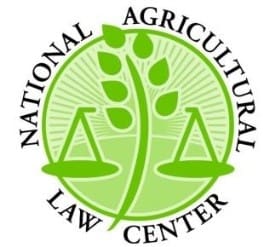A comprehensive summary of today’s judicial, legislative, and regulatory developments in agriculture and food. Email important additions HERE.
ANNOUNCEMENT: Mark your calendar for the next Agricultural & Food Law Consortium webinar, Tuesday, January 16th: “The New Deal: Understanding and Negotiating Dairy Supply Contracts.” Details available here.
JUDICIAL: Includes landowner liability, environmental, estate planning, and pesticide issues.
In TAMARA BRYANT, Plaintiff, v. STATE OF COLORADO, DEPARTMENT OF TRANSPORTATION, JOHN WILLIAM REAMS, EARL BYRON REAMS, II, and THE H. NEIL REAMS FAMILY LLLP, a Colorado limited liability limited partnership, Defendants, No. 16-cv-01638-NYW, 2018 WL 273027 (D. Colo. January 3, 2018), plaintiff lost her arm after the car she was riding in struck defendant’s cow and overturned. Plaintiff argued the Colorado Dept. of Transportation (CDOT) was responsible for maintaining right of way fencing and their failure to do so “resulted in a fence line so deteriorated that it was no longer effective at preventing cattle from wandering out onto Colorado State Highways.” Defendant CDOT claimed no causation on their part as they did not have “actual notice of the compromised fencing for which it was responsible.” Evidence showed fence lines around the location of the crash “were in disrepair for many years and that CDOT received notice of such.” CDOT’s motion for summary judgment denied.
ATLANTIC RICHFIELD COMPANY, Petitioner, v. MONTANA SECOND JUDICIAL DISTRICT COURT, Silver Bow County, the Hon. Katherine M. Bidegaray, Respondent, OP 16-0555, 2017 WL 6629410 (Mont. December 29, 2017) involved environmental law issues wherein landowners near the site of a former smelter, “ordered to be cleaned up under the Comprehensive Environmental Response, Compensation, and Liability Act of 1980 (CERCLA),” sued smelter owner for restoration damages. Lower court granted landowners’ motion for summary judgment on site owner’s affirmative defenses as to “CERCLA preemption,” and smelter owner sought writ of “supervisory control.” State Supreme Court found landowners’ claim for restoration damages “arose solely under state common law and did not challenge the CERCLA cleanup.” The Court also determined landowners were not “potentially responsible parties” under CERCLA.
In re MARRIAGE OF ROBERT DAMBACHER, Petitioner-Appellant, and CHERYL DAMBACHER, Respondent-Appellee, NO. 4-16-0381, 2017 IL App (4th) 160381-U (Ill. Ct. App. December 22, 2017) involved a divorce and a dissolution of a corporation for which the parties were majority shareholders. The largest marital asset was a family farm, an S corporation, and the parties each held 35.02% ownership. Lower court required parties to “voluntarily” dissolve the S Corp, “liquidate its assets, pay its debts, and divide the proceeds among the shareholders according to the percentage of stocks owned by each shareholder.” Husband appealed, claiming court “lacked jurisdiction” to dissolve corporation. Appellate court affirmed, finding that the circuit court did not abuse its discretion by ordering the dissolution as evidence “clearly showed the parties could not cooperate in managing the Family Corporation, and they had no other significant assets that would have allowed one of them to buy the other one out.”
In CHERIEL JENSEN et al., Plaintiffs and Appellants, v. COUNTY OF SANTA CLARA et al., Defendants and Respondents, H042834, 2017 WL 6570723 (Cal. Ct. App. December 26, 2017), plaintiffs sought injunction after claiming defendants’ mosquito control methods, including “pesticide fogging,” violate the California Environmental Quality Act (CEQA). Court observed that “[t]he issue here is whether spraying pesticides from a public street causing particulate matter to land on private property is an activity” encompassed by the statute at issue. Court determined that the statue “is limited to situations where a district employee seeks to enter private property,” and does not apply “where no employee actually enters private property.”
LEGISLATIVE:
H.R. 4735: To provide compensation to persons injured by the Gold King Mine spill and fund certain long-term water quality monitoring programs. Bill referred to the House Committee on Agriculture, House Committee on Energy and Commerce, and 2 other committees.
REGULATORY: Includes AMS, FDA, and FS rules and notices.
AGRICULTURAL MARKETING SERVICE:
Rule implements a recommendation from the South Texas Onion Committee (Committee) to increase the assessment rate established for the 2017-18 and subsequent fiscal periods from $0.05 to $0.065 per 50-pound equivalent of onions handled under the Marketing Order (Order). Info here.
Rule implements a recommendation from the Processed Pear Committee (Committee) to increase the assessment rate established for the 2017-2018 and subsequent fiscal periods from $7.00 to $8.00 per ton of “summer/fall” pears for canning. Details here.
FOOD AND DRUG ADMINISTRATION: Rule FDA is announcing the availability of a guidance for industry entitled “Policy Regarding Certain Entities Subject to the Current Good Manufacturing Practice and Preventive Controls, Produce Safety, and/or Foreign Supplier Verification Programs.” Info here.
FOREST SERVICE:
Notice FS will prepare an environmental impact statement (EIS) for the Shasta Agness Landscape Restoration Project, which would implement multiple landscape restoration actions on National Forest System lands within an approximately 93,000-acre project planning area. Details here.
Notice FS announces a 14-day extension to the public scoping period on the notice of intent to prepare an environmental impact statement for the amendments to land management plans for greater sage-grouse conservation. Info here.
